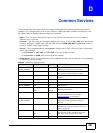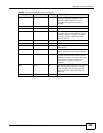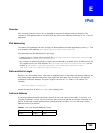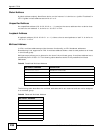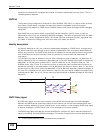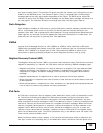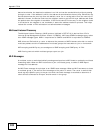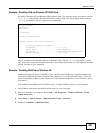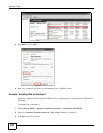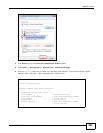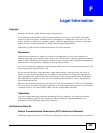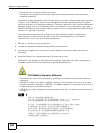
Appendix E IPv6
FMG3024-D10A / FMG3025-D10A Series User’s Guide
299
such as the system name. The interface-ID option provides slot number, port information and the
VLAN ID to the DHCPv6 server. The remote-ID option (if any) is stripped from the Relay-Reply
messages before the relay agent sends the packets to the clients. The DHCP server copies the
interface-ID option from the Relay-Forward message into the Relay-Reply message and sends it to
the relay agent. The interface-ID should not change even after the relay agent restarts.
Prefix Delegation
Prefix delegation enables an IPv6 router to use the IPv6 prefix (network address) received from the
ISP (or a connected uplink router) for its LAN. The Device uses the received IPv6 prefix (for
example, 2001:db2::/48) to generate its LAN IP address. Through sending Router Advertisements
(RAs) regularly by multicast, the Device passes the IPv6 prefix information to its LAN hosts. The
hosts then can use the prefix to generate their IPv6 addresses.
ICMPv6
Internet Control Message Protocol for IPv6 (ICMPv6 or ICMP for IPv6) is defined in RFC 4443.
ICMPv6 has a preceding Next Header value of 58, which is different from the value used to identify
ICMP for IPv4. ICMPv6 is an integral part of IPv6. IPv6 nodes use ICMPv6 to report errors
encountered in packet processing and perform other diagnostic functions, such as "ping".
Neighbor Discovery Protocol (NDP)
The Neighbor Discovery Protocol (NDP) is a protocol used to discover other IPv6 devices and track
neighbor’s reachability in a network. An IPv6 device uses the following ICMPv6 messages types:
• Neighbor solicitation: A request from a host to determine a neighbor’s link-layer address (MAC
address) and detect if the neighbor is still reachable. A neighbor being “reachable” means it
responds to a neighbor solicitation message (from the host) with a neighbor advertisement
message.
• Neighbor advertisement: A response from a node to announce its link-layer address.
• Router solicitation: A request from a host to locate a router that can act as the default router and
forward packets.
• Router advertisement: A response to a router solicitation or a periodical multicast advertisement
from a router to advertise its presence and other parameters.
IPv6 Cache
An IPv6 host is required to have a neighbor cache, destination cache, prefix list and default router
list. The Device maintains and updates its IPv6 caches constantly using the information from
response messages. In IPv6, the Device configures a link-local address automatically, and then
sends a neighbor solicitation message to check if the address is unique. If there is an address to be
resolved or verified, the Device also sends out a neighbor solicitation message. When the Device
receives a neighbor advertisement in response, it stores the neighbor’s link-layer address in the
neighbor cache. When the Device uses a router solicitation message to query for a router and
receives a router advertisement message, it adds the router’s information to the neighbor cache,
prefix list and destination cache. The Device creates an entry in the default router list cache if the
router can be used as a default router.
When the Device needs to send a packet, it first consults the destination cache to determine the
next hop. If there is no matching entry in the destination cache, the Device uses the prefix list to



